steering MINI Hardtop 2 Door 2005 Owner's Manual
[x] Cancel search | Manufacturer: MINI, Model Year: 2005, Model line: Hardtop 2 Door, Model: MINI Hardtop 2 Door 2005Pages: 165, PDF Size: 2.32 MB
Page 4 of 165
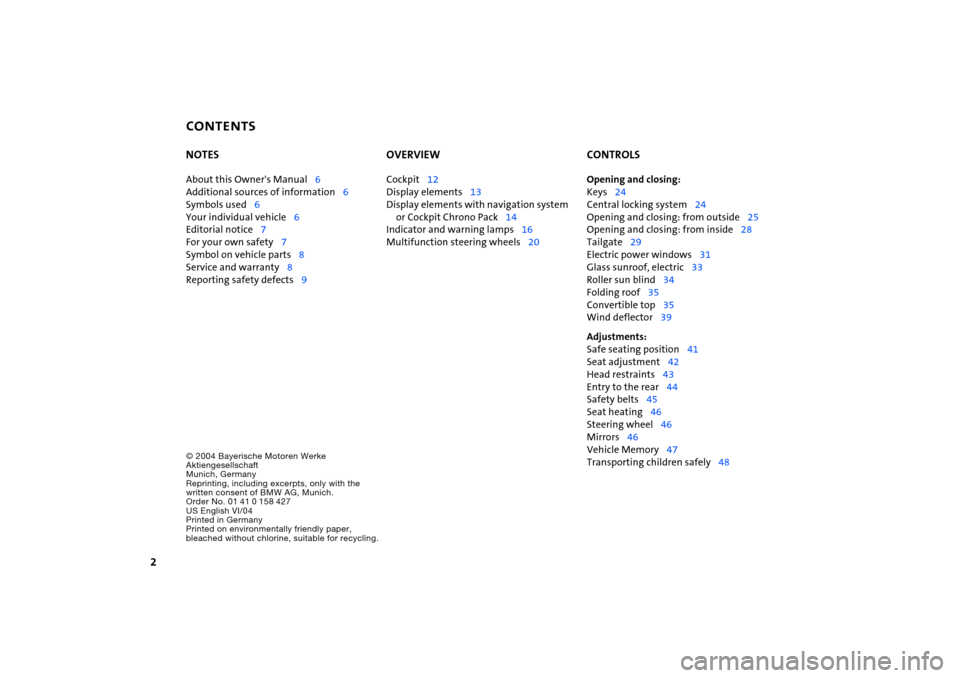
CONTENTS
2
© 2004 Bayerische Motoren Werke
Aktiengesellschaft
Munich, Germany
Reprinting, including excerpts, only with the
written consent of BMW AG, Munich.
Order No. 01 41 0 158 427
US English VI/04
Printed in Germany
Printed on environmentally friendly paper,
bleached without chlorine, suitable for recycling.NOTES About this Owner's Manual
6
Additional sources of information
6
Symbols used
6
Your individual vehicle
6
Editorial notice
7
For your own safety
7
Symbol on vehicle parts
8
Service and warranty
8
Reporting safety defects
9
OVERVIEWCockpit
12
Display elements
13
Display elements with navigation system
or Cockpit Chrono Pack
14
Indicator and warning lamps
16
Multifunction steering wheels
20
CONTROLSOpening and closing:Keys
24
Central locking system
24
Opening and closing: from outside
25
Opening and closing: from inside
28
Tailgate
29
Electric power windows
31
Glass sunroof, electric
33
Roller sun blind
34
Folding roof
35
Convertible top
35
Wind deflector
39
Adjustments:Safe seating position
41
Seat adjustment
42
Head restraints
43
Entry to the rear
44
Safety belts
45
Seat heating
46
Steering wheel
46
Mirrors
46
Vehicle Memory
47
Transporting children safely
48
Page 14 of 165
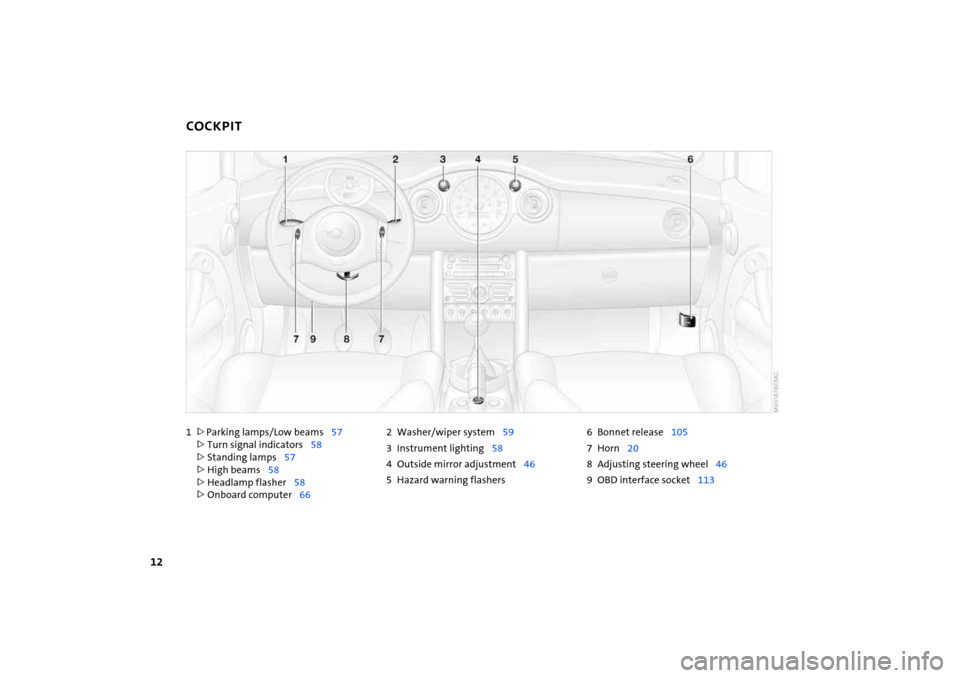
12
1>
Parking lamps/Low beams
57
>Turn signal indicators
58
>Standing lamps
57
>High beams
58
>Headlamp flasher
58
>Onboard computer
66
2Washer/wiper system
59
3 Instrument lighting
58
4 Outside mirror adjustment
46
5 Hazard warning flashers
6 Bonnet release
105
7Horn
20
8 Adjusting steering wheel
46
9OBD interface socket
113
COCKPIT
Page 18 of 165
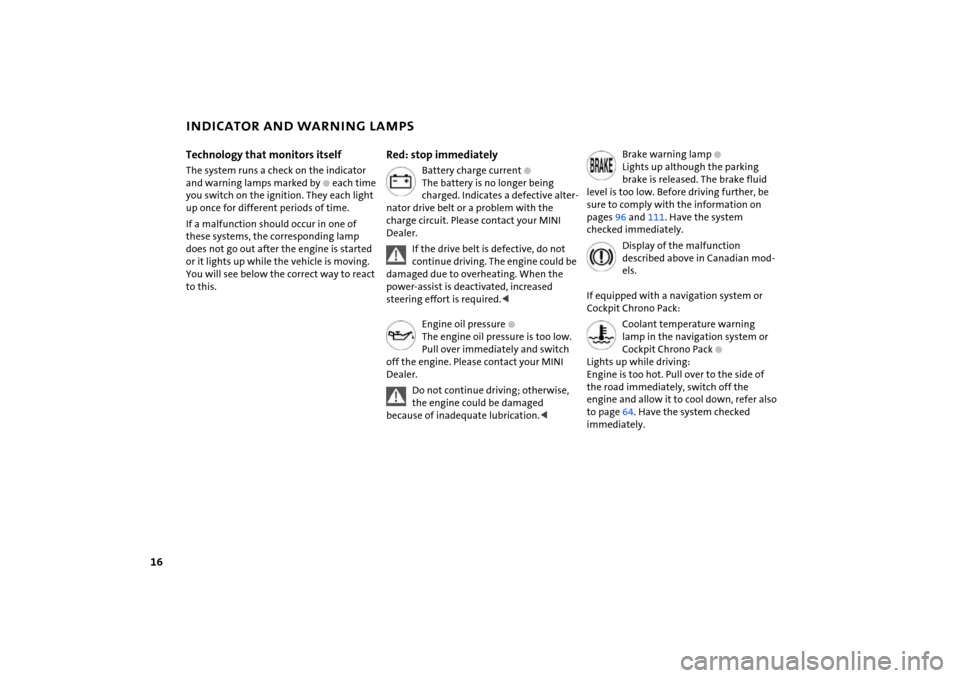
16
INDICATOR AND WARNING LAMPS Technology that monitors itselfThe system runs a check on the indicator
and warning lamps marked by
+ each time
you switch on the ignition. They each light
up once for different periods of time.
If a malfunction should occur in one of
these systems, the corresponding lamp
does not go out after the engine is started
or it lights up while the vehicle is moving.
You will see below the correct way to react
to this.
Red: stop immediately
Battery charge current
+
The battery is no longer being
charged. Indicates a defective alter
-
nator drive belt or a problem with the
charge circuit. Please contact your MINI
Dealer.
If the drive belt is defective, do not continue driving. The engine could be
damaged due to overheating. When the
power-assist is deactivated, increased
steering effort is required.
The engine oil pressure is too low.
Pull over immediately and switch
off the engine. Please contact your MINI
Dealer.Do not continue driving; otherwise, the engine could be damaged
because of inadequate lubrication.<
Brake warning lamp
+
Lights up although the parking
brake is released. The brake fluid
level is too low. Before driving further, be
sure to comply with the information on
pages 96 and
111
. Have the system
checked immediately.
Display of the malfunction described above in Canadian mod
-
els.
If equipped with a navigation system or
Cockpit Chrono Pack:
Coolant temperature warning lamp in the navigation system or
Cockpit Chrono Pack
+
Lights up while driving:
Engine is too hot. Pull over to the side of
the road immediately, switch off the
engine and allow it to cool down, refer also
to page
64. Have the system checked
immediately.
Page 21 of 165
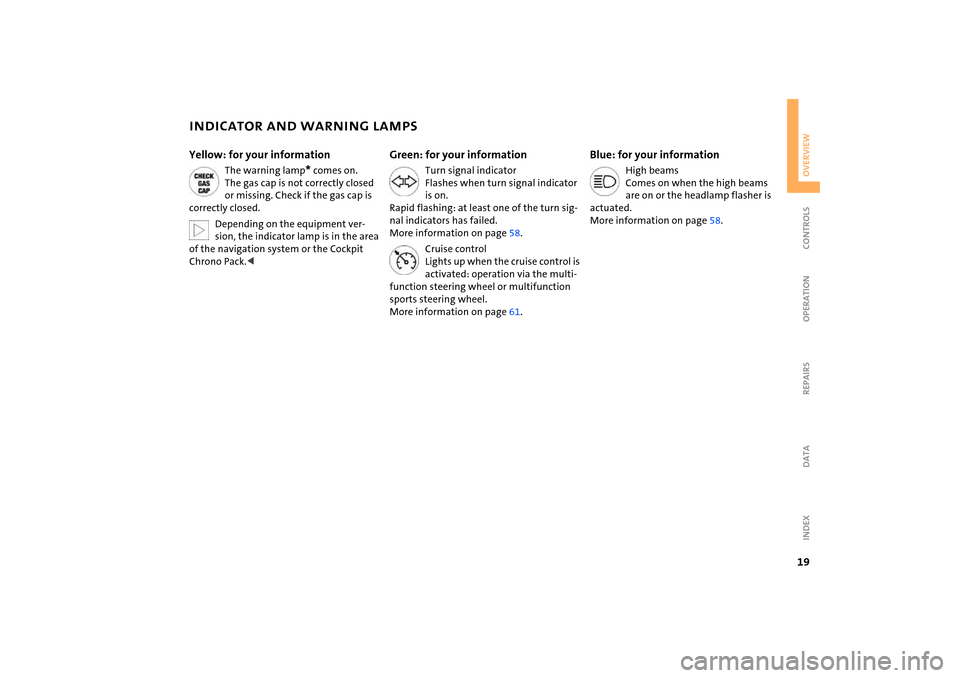
19
OVERVIEW REPAIRS OPERATION CONTROLS DATA INDEX
INDICATOR AND WARNING LAMPSYellow: for your information
The warning lamp
* comes on.
The gas cap is not correctly closed
or missing. Check if the gas cap is
correctly closed.Depending on the equipment ver
-
sion, the indicator lamp is in the area
of the navigation system or the Cockpit
Chrono Pack.<
Green: for your information
Turn signal indicator
Flashes when turn signal indicator
is on.
Rapid flashing: at least one of the turn sig
-
nal indicators has failed.
More information on page
58.
Cruise control
Lights up when the cruise control is
activated: operation via the multi
-
function steering wheel or multifunction
sports steering wheel.
More information on page
61.
Blue: for your information
High beams
Comes on when the high beams
are on or the headlamp flasher is
actuated.
More information on page
58.
Page 22 of 165
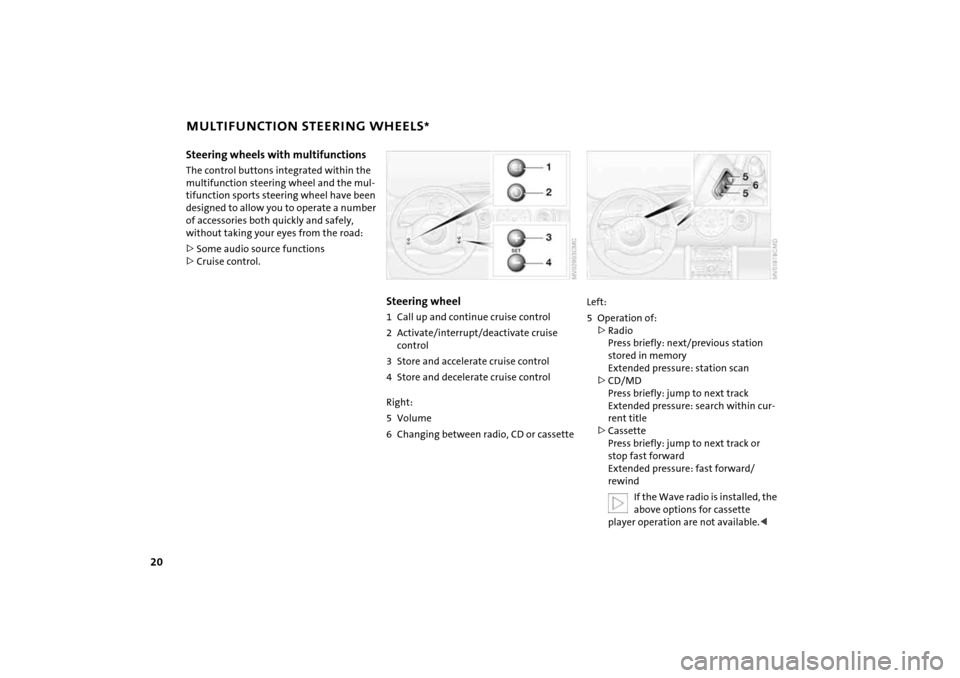
20
MULTIFUNCTION STEERING WHEELS
*
Steering wheels with multifunctionsThe control buttons integrated within the
multifunction steering wheel and the mul
-
tifunction sports steering wheel have been
designed to allow you to operate a number
of accessories both quickly and safely,
without taking your eyes from the road:>Some audio source functions>Cruise control.
Steering wheel1 Call up and continue cruise control2 Activate/interrupt/deactivate cruise
control3 Store and accelerate cruise control 4 Store and decelerate cruise control Right:5Volume6 Changing between radio, CD or cassette
Left:5 Operation of:>Radio
Press briefly: next/previous station
stored in memory
Extended pressure: station scan>CD/MD
Press briefly: jump to next track
Extended pressure: search within cur
-
rent title>Cassette
Press briefly: jump to next track or
stop fast forward
Extended pressure: fast forward/
rewind
If the Wave radio is installed, the above options for cassette
player operation are not available.<
Page 23 of 165
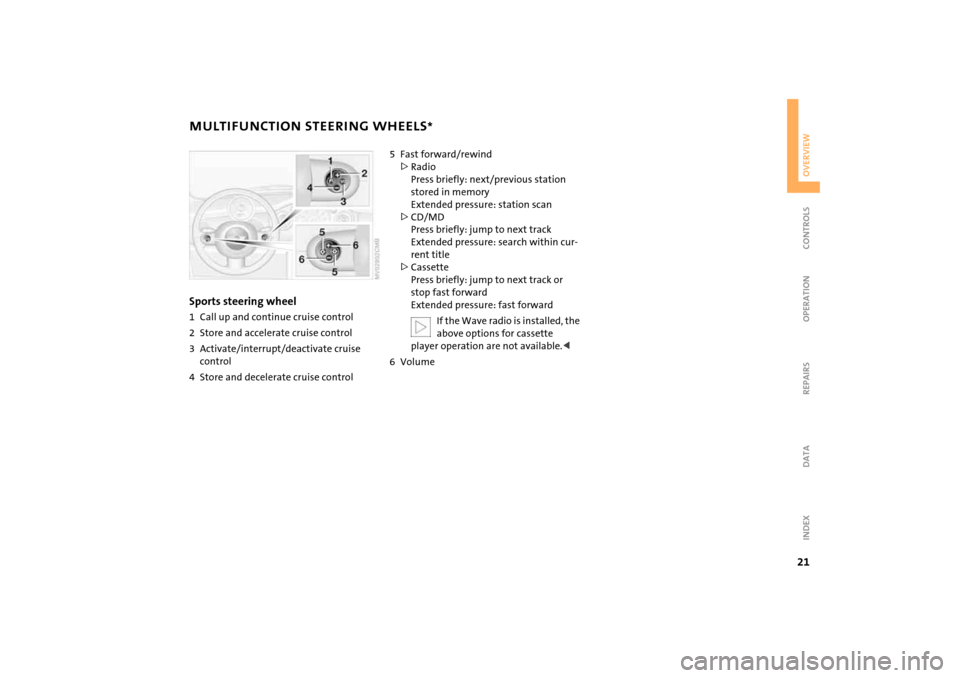
21
OVERVIEW REPAIRS OPERATION CONTROLS DATA INDEX
MULTIFUNCTION STEERING WHEELS
*
Sports steering wheel1 Call up and continue cruise control2 Store and accelerate cruise control 3 Activate/interrupt/deactivate cruise
control4 Store and decelerate cruise control
5 Fast forward/rewind>Radio
Press briefly: next/previous station
stored in memory
Extended pressure: station scan>CD/MD
Press briefly: jump to next track
Extended pressure: search within cur
-
rent title>Cassette
Press briefly: jump to next track or
stop fast forward
Extended pressure: fast forward
If the Wave radio is installed, the above options for cassette
player operation are not available.<
6Volume
Page 43 of 165
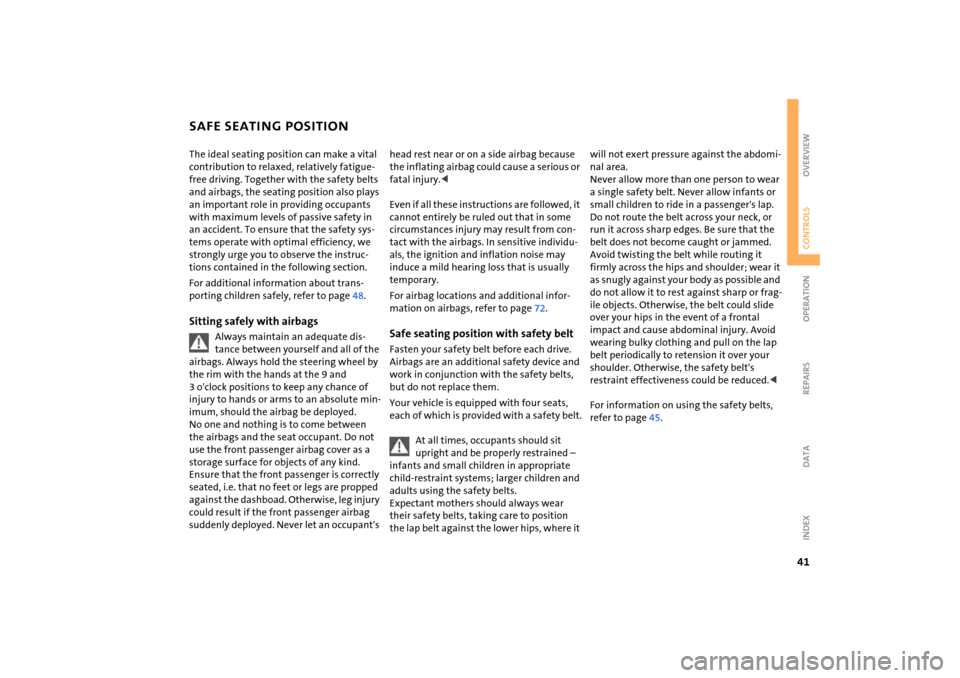
41
OVERVIEW REPAIRS OPERATIONCONTROLS DATA INDEX
SAFE SEATING POSITIONThe ideal seating position can make a vital
contribution to relaxed, relatively fatigue-
free driving. Together with the safety belts
and airbags, the seating position also plays
an important role in providing occupants
with maximum levels of passive safety in
an accident. To ensure that the safety sys
-
tems operate with optimal efficiency, we
strongly urge you to observe the instruc
-
tions contained in the following section.For additional information about trans
-
porting children safely, refer to page
48.
Sitting safely with airbags
Always maintain an adequate dis
-
tance between yourself and all of the
airbags. Always hold the steering wheel by
the rim with the hands at the 9 and
3
o'clock positions to keep any chance of
injury to hands or arms to an absolute min
-
imum, should the airbag be deployed.
No one and nothing is to come between
the airbags and the seat occupant. Do not
use the front passenger airbag cover as a
storage surface for objects of any kind.
Ensure that the front passenger is correctly
seated, i.e. that no feet or legs are propped
against the dashboad. Otherwise, leg injury
could result if the front passenger airbag
suddenly deployed. Never let an occupant's
head rest near or on a side airbag because
the inflating airbag could cause a serious or
fatal injury.
circumstances injury may result from con
-
tact with the airbags. In sensitive individu
-
als, the ignition and inflation noise may
induce a mild hearing loss that is usually
temporary. For airbag locations and additional infor
-
mation on airbags, refer to page
72.
Safe seating position with safety belt Fasten your safety belt before each drive.
Airbags are an additional safety device and
work in conjunction with the safety belts,
but do not replace them.Your vehicle is equipped with four seats,
each of which is provided with a safety belt.
At all times, occupants should sit upright and be properly restrained –
infants and small children in appropriate
child-restraint systems; larger children and
adults using the safety belts.
Expectant mothers should always wear
their safety belts, taking care to position
the lap belt against the lower hips, where it
will not exert pressure against the abdomi
-
nal area.
Never allow more than one person to wear
a single safety belt. Never allow infants or
small children to ride in a passenger's lap.
Do not route the belt across your neck, or
run it across sharp edges. Be sure that the
belt does not become caught or jammed.
Avoid twisting the belt while routing it
firmly across the hips and shoulder; wear it
as snugly against your body as possible and
do not allow it to rest against sharp or frag
-
ile objects. Otherwise, the belt could slide
over your hips in the event of a frontal
impact and cause abdominal injury. Avoid
wearing bulky clothing and pull on the lap
belt periodically to retension it over your
shoulder. Otherwise, the safety belt's
restraint effectiveness could be reduced.
45.
Page 48 of 165
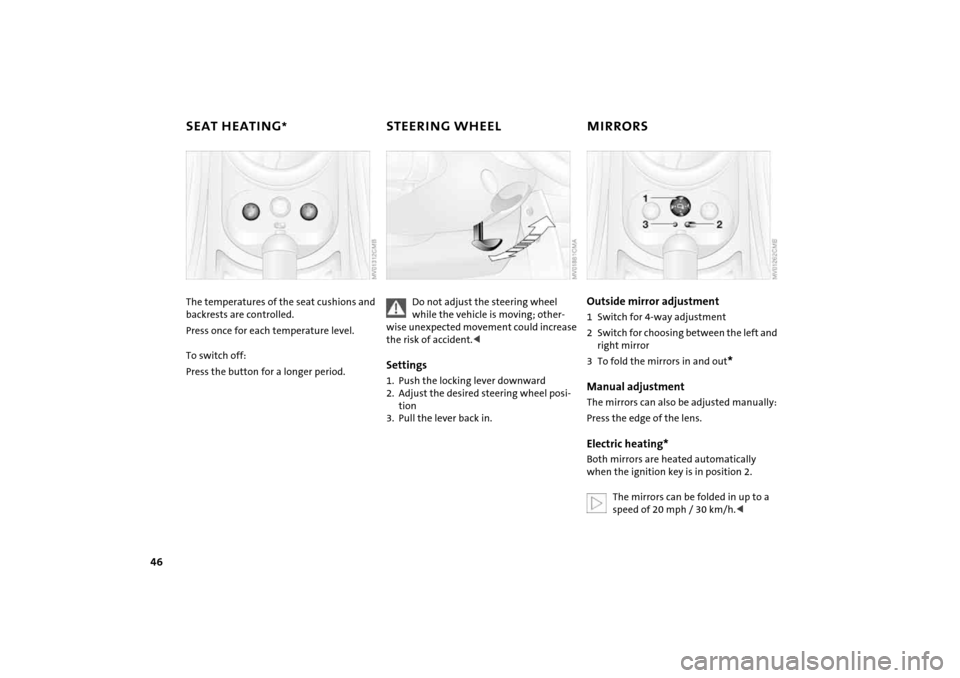
46
SEAT HEATING
*
STEERING WHEEL
MIRRORS
The temperatures of the seat cushions and backrests are controlled.Press once for each temperature level.To switch off:Press the button for a longer period.
Do not adjust the steering wheel while the vehicle is moving; other
-
wise unexpected movement could increase
the risk of accident.
tion
3. Pull the lever back in.
Outside mirror adjustment1 Switch for 4-way adjustment 2 Switch for choosing between the left and
right mirror 3 To fold the mirrors in and out
*
Manual adjustmentThe mirrors can also be adjusted manually: Press the edge of the lens.Electric heating* Both mirrors are heated automatically
when the ignition key is in position
2.
The mirrors can be folded in up to a speed of 20
mph
/ 30 km/h.<
Page 53 of 165

51
OVERVIEW REPAIRS OPERATIONCONTROLS DATA INDEX
IGNITION LOCK
STARTING THE ENGINE
0 Steering locked
The key can be inserted or removed in this
position only.To lock the steering:1. Remove the key2. Turn the steering wheel slightly to the
left or right until the lock engages.A sound alarm goes off if the key remains in
the ignition after opening the driver's door.Interlock Vehicles with Continuously Variable auto
-
matic Transmission (CVT):
The ignition key cannot be turned to
position
0 and removed until the selector
lever is in position
P.
1 Steering unlocked
Individual electrical accessories are ready
for operation.You will find that it is often easier to turn
the ignition key from position
0 to
position
1 when you move the steering
wheel slightly to help disengage the lock.
2 Ignition switched on
All electrical accessories are ready for oper
-
ation.3 Starting the engine
Vehicles with manual transmission:
Step on the clutch when starting the
vehicle. A lockout prevents the engine from
starting if the clutch is not depressed.<
Do not allow the engine to run in enclosed spaces. Breathing the nox
-
ious exhaust gases can lead to uncon
-
sciousness and death. The exhaust gases
contain carbon monoxide, an odorless and
colorless, but highly toxic gas.
Do not leave the vehicle unattended with
the engine running. This is a safety hazard.
When driving, standing at idle, and parking
the vehicle, take care to avoid contact
between the hot exhaust system and flam
-
mable materials, e.g. hay, grass, leaves, etc.
Such contact could lead to a fire resulting in
serious personal injury and property dam
-
age.
vehicle at a standstill. Move off immedi
-
ately at a moderate engine speed.
Page 54 of 165
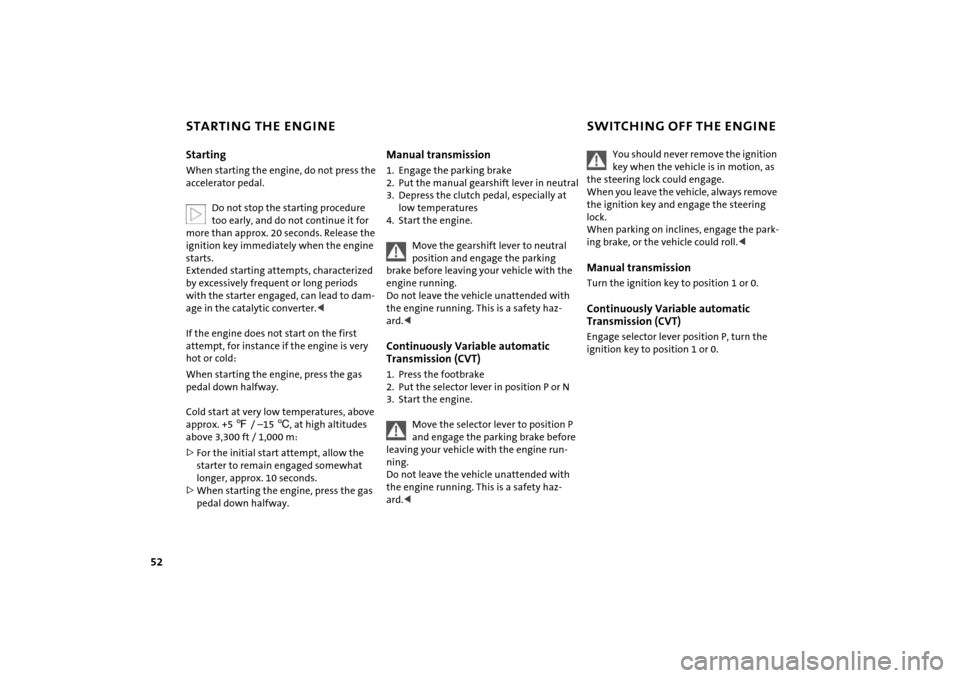
52
STARTING THE ENGINE
SWITCHING OFF THE ENGINE
StartingWhen starting the engine, do not press the
accelerator pedal.
Do not stop the starting procedure too early, and do not continue it for
more than approx. 20
seconds. Release the
ignition key immediately when the engine
starts.
Extended starting attempts, characterized
by excessively frequent or long periods
with the starter engaged, can lead to dam
-
age in the catalytic converter.
hot or cold:When starting the engine, press the gas
pedal down halfway.Cold start at very low temperatures, above
approx. +5
7
/ –15
6, at high altitudes
above 3,300
ft / 1,000 m:
>For the initial start attempt, allow the
starter to remain engaged somewhat
longer, approx. 10
seconds.
>When starting the engine, press the gas
pedal down halfway.
Manual transmission1. Engage the parking brake2. Put the manual gearshift lever in neutral3. Depress the clutch pedal, especially at
low temperatures4. Start the engine.
Move the gearshift lever to neutral position and engage the parking
brake before leaving your vehicle with the
engine running.
Do not leave the vehicle unattended with
the engine running. This is a safety haz
-
ard.
P or N
3. Start the engine.
Move the selector lever to position
P
and engage the parking brake before
leaving your vehicle with the engine run
-
ning.
Do not leave the vehicle unattended with
the engine running. This is a safety haz
-
ard.<
You should never remove the ignition key when the vehicle is in motion, as
the steering lock could engage.
When you leave the vehicle, always remove
the ignition key and engage the steering
lock.
When parking on inclines, engage the park
-
ing brake, or the vehicle could roll.
Continuously Variable automatic
Transmission (CVT)Engage selector lever position
P, turn the
ignition key to position
1 or 0.